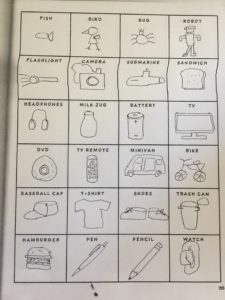“David, don’t doodle”
This is one of my earliest memories in school. I had already written down the homework information and the teacher walked over as I was doodling a bit in my book. She explained that I needed to take my schoolwork more seriously (in this, she was right) and that my doodles were an example of me not doing so.
That’s what “notes” were in my academic years. They were words. They were neatly hand-written. They were, in a word, serious.
But that’s starting to change. Sketchnotes – a form of visual note-taking consisting of a mix of handwriting, drawings, and other visual elements – is growing in popularity. I see it often in conferences I speak at, and I see it being used in training and educational settings. I wanted to learn more about this practice, and learn how I could improve my own notes through the practice.
That’s what led me to this book.
 About the Book
About the Book
The Sketchnote Handbook is an illustrated book from Mike Rohde that explains what sketchnotes are, what their value is, and how to create sketchnotes for yourself. The book is broken up into seven chapters:
- What are sketchnotes?
- Why sketchnotes?
- Listen up!
- The sketchnoting process
- Types of sketchnotes
- Sketchnoting approaches, hierarchy, and personalization
- Sketchnoting skills & techniques
The book follows a natural learning flow, with each chapter building on the lessons of the last. At the same time, any of the chapters can be referenced on its own to dig into the specific knowledge or skills being addressed.
What I Liked
First and foremost, this is a gorgeous book. This book isn’t just an instructional guide to sketchnoting, it also feels like a love letter to the practice. The book doesn’t just tell you about sketchnoting; it fully embodies it, as if the author had asked himself the question “Why would I write a book about sketchnotes when I can actually sketchnote one?”
In truth, the book isn’t entirely sketchnoted. Much of the writing is a font, but it is a font based on the author’s handwriting. I think this is a telling point, as it very well represents the author’s desire to have this book be an example of sketchnotes in practice – and it completely succeeds in that.
I also very much appreciated the variety of sketches and artists that were featured in the book. Without them, a reader could easily assume that the author’s personal style of sketchnoting was the template that should be followed. The other notes included in the book showed other approaches to visual note-taking, many of which were very different in style and structure from the author. This expanded the perspective of what sketchnotes can be for the readers. The choice to end each chapter with a couple of sketchnotes from other visual note takers sharing their sketchnoting tips was also a nice touch.
My favorite part of the book were the latter chapters that started to put sketchnotes into action, as they addressed my biggest obstacle with visual note-taking: I can’t draw.
I’ve often been correctly, and occasionally chastised, for making that statement. Sketchnotes aren’t about talent and artistry, I’ve been repeatedly told; they’re more about structure. And while I logically understood that when people said it to me, I never really truly believed it. I’ve always looked at other’s sketchnotes with envy, dismissing them as something I could never do because “I can’t draw”.
This book does an amazing job of separating the art from the structure. It presents the building blocks of visual structure that are critical, and examines how your art can enhance the structure. It also breaks the “drawing” part down into individual elements, as the reader discovers how just about any visual can be effectively conveyed with the combination of only a few simple shapes.

My sketches from an exercise in the book.
It was the book’s ability to get me over the hurdle of “I can’t draw” that most impressed me. Don’t get me wrong, I still think I’m a pretty sucky artist, but I also know that my skills will improve relative to the amount of time I dedicate to practice. Even without increasing my artistry, now that I understand the structure of sketchnote and the building blocks of any drawing, I can create a basic image of just about anything. It may not be world-class art, but it can effectively convey meaning to most people who look at it.
Getting someone who “can’t draw” to that place is powerful, and speaks to the effectiveness of the book.
Most of all, I appreciated the fact that this book is sketchnoting in practice. Every page was created as its own sketchnote, so not only was I learning from the narrative formed by the words, but I was also learning from the examples the author created for the book. I was learning about sketchnoting via sketchnoting, in every sense of the word.
What I Would Like to Have Seen
One of the chapters I was most interested in – Why Sketchnoting? – was unfortunately one of the smallest in the book. This chapter explored the value of visual note-taking, and for me, that requires a certain rigor. It’s not enough to say that visual note-taking enhances retention; you really need to dive into the research and science to credibly discuss the value. And to the author’s credit, this chapter does that, mentioning dual coding theory, visual maps, and visual language. But I found myself wanting more in this section.
This is probably a good moment to revisit the heading of this section: What I Would Like to Have Seen. The most important word in that heading is *I*, as these aren’t necessarily flaws in the book; they are things that didn’t perfectly hit the bullseye that is me. I think that’s important to realize in this case as I think making this one of the shorter chapters of the book is probably the right decision. I would expect that the majority of readers probably aren’t as interested in the science of sketchnoting as I might be; they just want to start doodling.
My favorite part of the book was when I was able to start putting things into practice. The simple exercises included in the book were what ultimately got me past “I can’t draw”. I wanted more of that, and by the time I realized it, the book was over. Yes, I could (and did) very easily take what I learned and practice it informally, but I would have liked to see more opportunities to actively create visuals within the context of the book.
As an example, one of the major aspects of sketchnoting is that it’s in the moment. The book explores this, but it doesn’t do so in practice. I personally watched a few TED Talks online and sketched notes just to try out the live aspect of sketching, and the pressure of doing it in real-time completely changed the paradigm. The book discusses this challenge, but I found it to be like riding a bike – you can’t really appreciate creating sketchnotes in real-time based on someone’s description; you need to experience that moment to appreciate it. I would have liked to see the book incorporate opportunities for experiencing that within the context of the exercises.
The Verdict
If you’re new to the idea of sketchnoting, this is a great book to bring you up to speed. It’s provides foundational information about what sketchnotes are and how they work, and provides a great structure to follow to get started. The tips for creating visuals were especially appreciated, as they really drove home the point that sketchnotes are about communicating ideas, not about creating art.
While all of that is true, I don’t want to give the impression that this book is for beginners; the book provides a huge amount of value for experienced sketchnoters as well. Most of the people I know that create visual notes have always just done it. They formed their own practices and workflows just by doing it. For the experienced sketchnoter this book provides new possibilities that may not have been considered for efficiency, structure, and more. The examples alone can open your mind to possibilities you may never have considered before.
The points I made in the “What I Would Like to Have Seen section are minor, and more about my personal preferences. I think this is an excellent book and a great resource for anyone looking to get started or improve visual note-taking skills. More importantly, it’s an opportunity to help anyone communicate their ideas more effectively.







